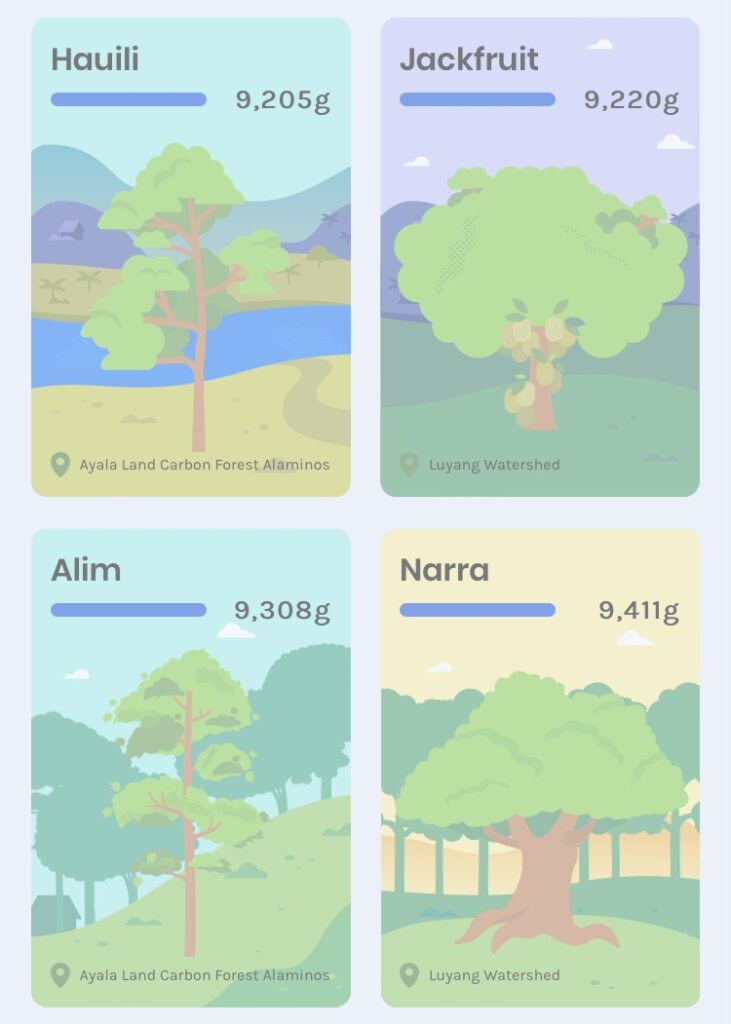GCash, apart from being widely used now as a preferred e-wallet app, is known by its user feature called GForest. By doing “green” or paperless transactions through the app—bank transfers, bill payments, paying through QR, etc.—and even just by walking around (if you give the app access to your phone’s activity), you earn “green energy.” The e-wallet app converts these “carbon offsets” to green energy points, represented by bubbles of differing values floating on top of your designated virtual tree. You accumulate points, which you can then use to adopt a native tree that GCash then plants to help repopulate critical areas like watersheds and forests around the country.
It is a noble idea—if you take away the fact that the same company built within GForest a feature that lets your “friends” steal a portion of your green energy when left unclaimed. But that’s just me, a user tired of being stolen from.
The feature now has 9 million users and as of January, it has planted a total of 1 million virtual trees that GCash pledged to plant in real life.
Only GCash can draw a tree
Apart from this environmental commitment, GForest also makes it easier for its user to identify and recognize these native tree species—if only by name since the illustrations help little in distinguishing these trees apart.
[READ: 5 endangered tree species in the Philippines]
Narra, our national tree, which you can plant for 9,411 green energy points, is vaguely visually represented with a wide trunk and foliage even a grade-schooler can draw. Such is also the case for molave and yakal whose only distinguishing features from narra are their slender trunks and branches.

Others have far more specific features: pointier and individually drawn leaves, foliage in a different shade of green, and for fruit-bearing trees, well, fruits (though they barely resemble the real thing) to set them apart.
This could easily be chalked up to creative freedom. After all, the app does not claim to realistically portray these trees for these illustrations merely serve as visual aids. But one recent addition to the lineup of trees, as pointed out by artist and designer Karl Castro, made it impossible to suspend disbelief.
Is it an Antipolo tree or monstera?
For 18,410 green energy points, you can plant an Antipolo tree (Artocarpus blancoi) at the Davao Carbon Forest. It’s a fruit-bearing evergreen tree related to langka that can grow up to 30 meters tall. Apart from its height, one of its distinguishing features is its distinct large leaves with jagged edges.
Not only is the visual representation of the Antipolo tree in GForest without fruit, but it is also noticeably shorter. But perhaps its biggest slander is the fact that the artist commissioned to create its avatar confused its leaves for the popular houseplant monstera, known for its large “punctured” leaves.
The oversight led Castro to take to Instagram Stories to call the attention of GCash, but also to suggest that they hire local artists who specialize in the art of portraying native plant species in great detail.
These include illustrator Raxenne Maniquiz, artist Cynthia Bauzon-Arre, and multi-disciplinary queer artist John Chesleigh Nofiel a.k.a. Alaga at Sining.
In the post, he also advised the e-wallet app to consult with local environmental advocacy groups like Philippine Native Trees, Binhi, and Non-Timber Forest Products – Exchange Programme Philippines.
The clamor for the promotion of native tree species has been fervent in recent years for its benefits to restoring the country’s biodiversity as well as its role in climate change mitigation. Even with environmental protection laws and logging bans in place, online open-access platform Global Forest Watch (GFW) estimates that from 2002 up to 2020, the country lost 1.29 million hectares (12.9 billion square meters or about the size of more than 22,000 Rizal Parks).